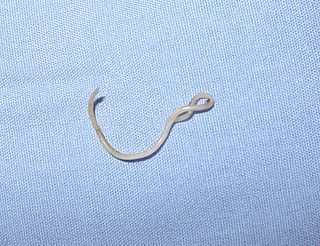
Flaviviridae is a family of enveloped positive-strand RNA viruses which mainly infect mammals and birds. They are primarily spread through arthropod vectors. The family gets its name from the yellow fever virus; flavus is Latin for "yellow", and yellow fever in turn was named because of its propensity to cause jaundice in victims. There are 89 species in the family divided among four genera. Diseases associated with the group include: hepatitis (hepaciviruses), hemorrhagic syndromes, fatal mucosal disease (pestiviruses), hemorrhagic fever, encephalitis, and the birth defect microcephaly (flaviviruses).
Veterinary parasitology is a branch of veterinary medicine that deals with the study of morphology, life-cycle, pathogenesis, diagnosis, treatment, and control of eukaryotic invertebrates of the kingdom Animalia and the taxon Protozoa that depend upon other invertebrates and higher vertebrates for their propagation, nutrition, and metabolism without necessarily causing the death of their hosts. Modern parasitology focuses on responses of animal hosts to parasitic invasion. Parasites of domestic animals,, as well as wildlife animals are considered. Data obtained from parasitological research in animals helps in veterinary practice and improves animal breeding. The major goal of veterinary parasitology is to protect animals and improve their health, but because a number of animal parasites are transmitted to humans, veterinary parasitology is also important for public health.
Toxocariasis is an illness of humans caused by the dog roundworm and, less frequently, the cat roundworm. These are the most common intestinal roundworms of dogs, coyotes, wolves and foxes and domestic cats, respectively. Humans are among the many "accidental" or paratenic hosts of these roundworms.

The Toxocaridae are a zoonotic family of parasitic nematodes that infect canids and felids and which cause toxocariasis in humans. The worms are unable to reproduce in humans.

Ascaris is a nematode genus of parasitic worms known as the "small intestinal roundworms", which is a type of parasitic worm. One species, Ascaris lumbricoides, affects humans and causes the disease ascariasis. Another species, Ascaris suum, typically infects pigs. Other ascarid genera infect other animals, such as Parascaris equorum, the equine roundworm, and Toxocara and Toxascaris, which infect dogs and cats.
Visceral larva migrans (VLM) is a condition in humans caused by the migratory larvae of certain nematodes, humans being a dead-end host, and was first reported in 1952. Nematodes causing such zoonotic infections are Baylisascaris procyonis, Toxocara canis, Toxocara cati, and Ascaris suum. These nematodes can infect but not mature in humans and after migrating through the intestinal wall, travel with the blood stream to various organs where they cause inflammation and damage. Affected organs can include the liver, heart and the CNS. A special variant is ocular larva migrans where usually T. canis larvae travel to the eye.

A pooper-scooper, or poop scoop, is a device used to pick up animal feces from public places and yards, particularly those of dogs. Pooper-scooper devices often have a bag or bag attachment. 'Poop bags' are alternatives to pooper scoopers, and are simply a bag, usually turned inside out, to carry the feces to a proper disposal area. Sometimes, the person performing the cleanup is also known as the pooper-scooper.

Ocular larva migrans (OLM), also known as ocular toxocariasis, is the ocular form of the larva migrans syndrome that occurs when Toxocara canis larvae invade the eye. They may be associated with visceral larva migrans. Unilateral visual disturbances, strabismus, and eye pain are the most common presenting symptoms.

Toxocara canis is a worldwide-distributed helminth parasite that primarily infects dogs and other canids, but can also infect other animals including humans. The name is derived from the Greek word "toxon," meaning bow or quiver, and the Latin word "caro," meaning flesh. T. canis live in the small intestine of the definitive host. This parasite is very common in puppies and somewhat less common in adult dogs. In adult dogs, infection is usually asymptomatic but may be characterized by diarrhea. By contrast, untreated infection with Toxocara canis can be fatal in puppies, causing diarrhea, vomiting, pneumonia, enlarged abdomen, flatulence, poor growth rate, and other complications.

Subclass Spiruria comprises mostly parasitic secernentean nematodes. In an alternate classification, they are treated as suborder Spirurina, with the orders listed here being ranked as infraorders.

The Ascarididae are a family of the large intestinal roundworms. Members of the family are intestinal parasites, infecting all classes of vertebrates. It includes a number of genera, the most well known of which are:

Toxocara cati, also known as the feline roundworm, is a parasite of cats and other felids. It is one of the most common nematodes of cats, infecting both wild and domestic felids worldwide. Adult worms are localised in the gut of the host. In adult cats, the infection – which is called toxocariasis – is usually asymptomatic. However, massive infection in juvenile cats can be fatal.

Toxascaris leonina is a common parasitic roundworm found in dogs, cats, foxes, and related host species. T. leonina is an ascarid nematode, a worldwide distributed helminth parasite which is in a division of eukaryotic parasites that, unlike external parasites such as lice and fleas, live inside their host. The definitive hosts of T. leonina include canids and felines (cats), while the intermediate hosts are usually rodents, such as mice or rats. Infection occurs in the definitive host when the animal eats an infected rodent. While T. leonina can occur in either dogs or cats, it is far more frequent in cats.

Norman Henry Ashton CBE, FRCP, FRCS, FRCPATH, FRCOphth, FRS was a British ophthalmologist and pathologist.

Baylisascaris procyonis, also known by the common name raccoon roundworm, is a roundworm nematode, found ubiquitously in raccoons, the definitive hosts. It is named after H. A. Baylis, who studied them in the 1920s–30s, and Greek askaris. Baylisascaris larvae in paratenic hosts can migrate, causing larva migrans. Baylisascariasis as the zoonotic infection of humans is rare, though extremely dangerous due to the ability of the parasite's larvae to migrate into brain tissue and cause damage. Concern for human infection has been increasing over the years due to urbanization of rural areas resulting in the increase in proximity and potential human interaction with raccoons.

Nitroscanate is an anthelmintic drug used in veterinary medicine to treat Toxocara canis, Toxascaris leonina, Ancylostoma caninum, Uncinaria stenocephala, Taenia, and Dipylidium caninum.

Retinal vasculitis is inflammation of the vascular branches of the retinal artery, caused either by primary ocular disease processes, or as a specific presentation of any systemic form of vasculitis such as Behçet's disease, sarcoidosis, multiple sclerosis, or any form of systemic necrotizing vasculitis such as temporal arteritis, polyarteritis nodosa, and granulomatosis with polyangiitis, or due to lupus erythematosus, or rheumatoid arthritis. Eales disease, pars planitis, birdshot retinochoroidopathy, and Fuchs heterochromic iridocyclitis (FHI) can also cause retinal vasculitis. Infectious pathogens such as Mycobacterium tuberculosis, visceral larva migrans can also cause retinal vasculitis. Drug-induced vasculitis may involve retina as well, as seen in methamphetamine induced vasculitis.
Toxocara malayasiensis is a species of feline roundworm, a parasite which infects the intestine of cats. Feline roundworms are passed in the fecal matter of cats, and can be transmitted to humans, causing toxocariasis, a potentially serious disease.
Fading puppy syndrome is when a puppy dies within the first few weeks of life without a clear cause of death or clinical signs, that is to say, they fail to thrive. Death usually occurs within the first five days of life, but can happen up to ten weeks of age. It is responsible for about 50% of deaths of new-born puppies.












